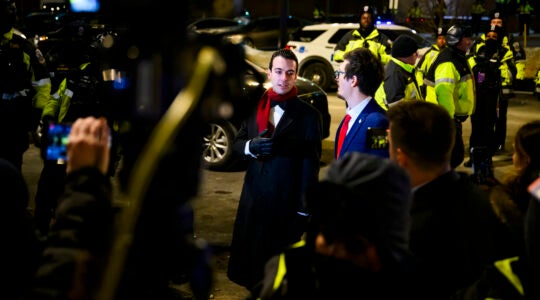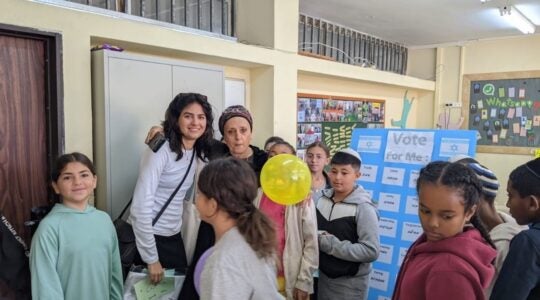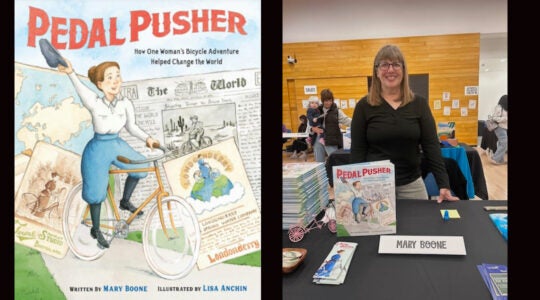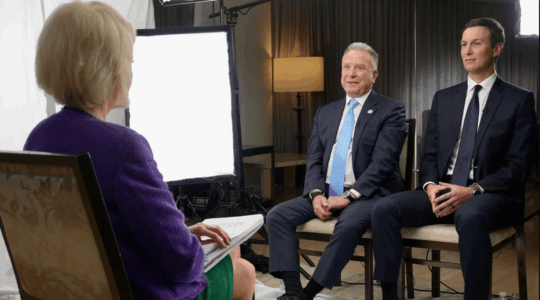NEW YORK (JTA) – As part of a move to revamp its fund-raising strategy, the United Jewish Communities has started a joint venture fund to raise significant dollars to help Israeli Arabs.
The organization, which serves as the umbrella of the North American federation system, is raising $750,000 from 15 private donors, foundations, federations and service organizations to start the UJC Venture Fund for Jewish-Arab Equality and Coexistence.
The first of several similar venture funds the UJC plans to roll out in coming months, the project is part of a new fund-raising model designed to attract new donors and revenue streams.
The model, which the UJC is calling “Collaborative Financial Resource Development,” is primarily focused on creating a new line of philanthropic enterprises and recruiting different funders to work on the projects.
Federations and the UJC would act as a convener and facilitator of those special projects, such as joint venture funds, that would not run through the federations’ general campaigns. They would give decision- making responsibilities to the donors.
“The primary purpose is to bring together people with different perspectives, such as private philanthropists and foundations, around an issue that needs to be elevated and highlighted in the Jewish community,” Carol Smokler, the chair of the venture fund, told JTA. “This is a new kind of venture. It is follow-your-dollar, hands-on involvement in an issue.”
The model is a central component to a strategic operations plan launched last year by the UJC to help boost the system’s financial intake.
The UJC wanted to re-examine the entire fund-raising system and “all of our resources,” said Barry Swartz, the organization’s senior vice president of continental community development and capacity building.
“We are beginning to tackle issues that not everybody might want to be involved with,” Swartz said.
The Israeli Arab joint venture fund and the similar funds to be introduced are intended to engage large donors the UJC has not been able to tap.
Other future funds might tackle such topics as Jewish identity among Israelis, Darfur refugees and guest workers in Israel, women’s issues, programs for gifted students and programming designed to integrate the disabled into Jewish life, a UJC source said.
For Swartz, the Israeli Arab venture fund is the ideal place to start.
Some 52 percent of the Israeli Arab community lives in poverty, according to the UJC, and observers see unrest in that community as one of Israel’s greatest threats.
But the Israeli Arab issue is a hot-button topic within the Jewish philanthropic world, and while a number of major Jewish philanthropies have taken up the issue in recent years, many federations have shied away from it for fear of alienating donors to their annual campaigns who do not want to see their charitable dollars go to the non-Jewish community and specifically the Arab sector.
Some right-wing Jews vociferously objected after the UJC used some of the money it collected to help Israel rebuild after the Lebanon war in 2006 to help the Israeli Arab community.
For the new initiative, the UJC has garnered gifts of $50,000 each from 15 donors to start the fund. Some of the initial investors are fairly close with the system, including UJC Chairman Joseph Kanfer and the American Jewish Joint Distribution Committee.
But it has also drawn new faces to UJC, which is one of its primary goals.
The Naomi and Nehemiah Cohen Foundation, the Rita and Harold Divine Foundation, the Alan B. Slifka Foundation and the Everett Foundation each have pledged $50,000 to the project, and none have been major collaborators with federations in the recent past, according to Swartz.
Edith Everett, the president of the Everett Foundation, says she has long been wary of investing her charitable dollars in the Jewish federation system.
She said the system is typically too slow and clunky to carry out her philanthropic wishes. Working with a federation meant watching projects “go from committee to committee to committee, and then never see the light of day,” she said.
“It was way too complicated and costly to go through the federation” to carry out specific charitable goals, said Everett, who has opted for other avenues for her philanthropic dollars in Israel and elsewhere.
The details of the venture fund are still unclear as its board, comprised of donors to the fund, met for the first time last month. But it will most likely be run like a donor-advised fund in which donors make their contributions and decide later as a group how to use them.
It is unclear whether the board will give away all $750,000 it collects at one time or use the money to create an endowment fund that doles out a portion of its assets each year, Swartz said.
The decisions made by the board of donors will be executed by UJC staff.
That model, and the trust of some laypeople involved in the project, that convinced Everett to participate, she said.
“I think people who are unfamiliar with the system have been a little wary of getting involved. They are used to doing their own business,” Smokler said. “But all of the partners have an equal vote, and that has been exciting to people.”
The UJC also wants local federations to adopt the collaborative resource development model, Swartz said.
Its system has long been essentially a tale of fund-raising halves – the small donors who give to the federations’ annual campaigns, and large donors who donate to the campaigns and a handful of specialized projects.
The collaborative model is designed to offer a wider array of giving opportunities, including these venture funds, Swartz said. One of its primary goals is to make individual federations figure out how to work with local foundations on specific projects.
The program is now being piloted in 17 communities.
“It will be an interesting experience to see how a group like this comes together on a continental basis to make decisions,” Swartz said. “We don’t want to be seen as an obstacle but as honest brokers. I think it is an interesting new wrinkle.”
JTA has documented Jewish history in real-time for over a century. Keep our journalism strong by joining us in supporting independent, award-winning reporting.





